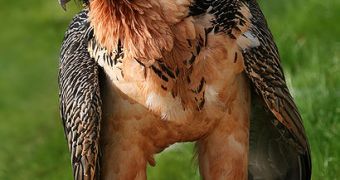Scientists have recently discovered a previously unknown type of structure in birds' wings that is apparently responsible for creating a silver sheen in some species' wings. The weird thing is that, otherwise, these feathers would be completely black, the investigators say. They add that the new phenomenon is very different from the iridescence effect that causes plumages to appear to be colored differently, depending on the angle a viewer watches them, the BBC News reports.
“We fell in love with the bearded vulture, a striking, rare bird of the Pyrenees. What struck us was how conspicuous the adult birds were, especially in the sun. The wing, back and tail feathers of these birds had a silvery sheen. Later, one of us was handling red-footed boobies and was immediately struck by how much their flight feathers on the wing resembled those of the bearded vulture,” Dr. Ismael Galvan, an expert at the National Museum of Natural Sciences, in Madrid, Spain, and the leader of the new research, says. Scientists from Spain and Canada also contributed to the investigation.
According to the team, bird species with silver sheens on their feathers include pelicans, ducks, vultures and cranes. More details of their study are published in the latest issue of the Journal of Avian Biology. The scientists also observed that smaller bird species, such as songbirds, did not possess this trait. Rather, it was reserved for large, open-habitat species. This difference made the experts wonder as to what caused the unusual phenomenon. They suspected that pigments had nothing to do with it, and so they began to search for the answer in the structure of the feathers themselves.
In order to view such small details, they used light and scanning electron microscopes. The latter has a single-atom resolution. They noticed that, for the most parts, all feathers looked the same. From the central structure, or axis, known as the rachis, a number of perpendicular features, known as barbes, branched off. Each of the barbes, in turn, had a number of barbules branching off. The latter structures are usually tied together, to give the feather its strength. The team noticed that the barbules on the silver-sheen feathers were longer than usual, and that, most importantly, they seemed to twist.
“This is how the sheen coloration is generated, without the occurrence of coherent scattering like in 'traditional' structural feathers,” Galvan says. The structure is very fragile, the expert adds. When the investigators scrapped the surface of the feather with a pair of scissors, it lost its silvery sheen, the team reports. “What is really a surprise is how fragile this structure is. One can easily scrape off the color with a dull blade, and so old feathers on birds are easily recognized from new ones. In some cases the color shifts from white to black,” the expert concludes.

 14 DAY TRIAL //
14 DAY TRIAL //